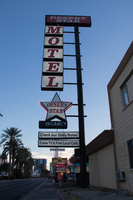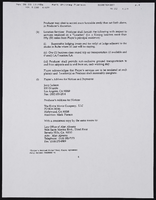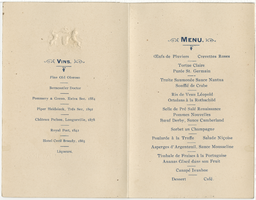Search the Special Collections and Archives Portal
Search Results

Photographs of Desert Star Motel sign, Las Vegas (Nev.), March 24, 2017
Date
Archival Collection
Description
Site address: 1210 S Las Vegas Blvd
Sign owner: Desert Star Motel Enterprises
Sign details: The original construction of this motel was in 1961 and has acted as a motel since.
Sign condition: 3, sign is in decent condition. Some portions of it do not light up anymore.
Sign form: Roadside pole sign
Sign-specific description: This sign sits directly on the roadside along Las Vegas Boulevard. The sign consists of a large black pole with many different back lit signs extending toward Las Vegas Boulevard attached to it. Staring from the top of the sign. There is a plastic back lit sign reading "DESERT STAR" in bold white letters against a red background. Under this are individual square signs each containing one letter. Moving down the length of the pole they spell out the word "MOTEL". Each of these letters are red against a white background. Under this series of letters is a star shaped back lit sign reading "DESERT STAR" in bold red text against a white background. This sign is outlined by a neon tube that no longer works. Attached to the bottom points of the star is a rectangular back sign with "VACANCY" painted on it in white. Neon tubes outline the word "NO" as well as "VACANCY." Under this sign is another plastic back lit sign reading "Check Out our Weekly & Daily Rates" in white letters against a red background. Finally, the last portion of this sign is another plastic back lit sign reading "Free Local Calls" in white letters against a red background.
Sign - type of display: Neon and back lit plastic sign
Sign - media: Steel and plastic
Sign - non-neon treatments: Plastic backlit sign
Sign environment: This motel sits very close to the intersection of Las Vegas Boulevard and Charleston. It is a short distance away from the Arts District and Fremont Street. It is a few blocks north of the Stratosphere hotel. A few properties that are close to this motel are the Little White Wedding Chapel as well as many other hostels and motels.
Sign - date of redesign/move: From an earlier photograph, this sign has changed from what appears to might have been their original sign. There is no exact year when the sign changed. The sign that they had in the 60s looks similar to their sign today, but with different colors. The earlier sign had the same "MOTEL" running down the side of the pole, but the letters were black against a yellow background and the pole was white. The star under this was white with forest green letters reading "DESERT STAR." There were three other rectangular signs under this. Each of these had forest green letters against a white background. The sign under the star sign and the "NO VACANCY" attached to that read " TV PHONES." The second sign said "REFRIGERATION." And the third said "AAA HEATED POOL."
Sign - thematic influences: The name "DESERT STAR" could've taken influence from the Space Age. There were plenty of motels that had a star theme or "star" in their name all throughout the city.
Sign - artistic significance: This is a good example of how roadside signs could be simple, yet eye catching to motorists and pedestrians. It does keep in theme with many of the other motel signs throughout the city by sitting directly along the roadside to be noticeable.
Survey - research locations: Assessor's Page, Stephani Drives Las Vegas Website http://stefanidrivesvegas.com/8.html
Survey - research notes: There in not much information on the history of this property.
Surveyor: Emily Fellmer
Survey - date completed: 2017-09-09
Sign keywords: Neon; Plastic; Backlit; Steel; Roadside; Pole sign
Mixed Content

Transcript of interview with Marian Beltran Decaro by Frank Murillo, March 27, 1977
Date
Archival Collection
Description
On March 27, 1977, Frank Murillo interviewed housewife Marian Beltran Decaro (born September 7th, 1914 in Flagstaff, Arizona) in her home in Las Vegas, Nevada. This interview covers the history of Las Vegas, Nevada’s first Mexican restaurant. Mr. Decaro is also present during the interview. Additionally, Mrs. Decaro recalls the first atomic bomb test in Las Vegas and also offers an overview of the growth of the area, overall, including the development and demographic details of such distinct historical communities as the Westside.
Text

Transcript of interview with Louis Evans by Jeannettte Lonpergan, February 17, 1976
Date
Archival Collection
Description
On February 17, 1976, Jeannette Lonpergan interviewed well driller and dairy worker, Mr. Louis Evans (born on August 8th, 1914 in Jones County, Iowa) in his home in Las Vegas, Nevada. Mrs. Lonpergan’s husband, Mr. Dennis Lonpergan, was present during the interview and joined in on the discussion. Mr. Louis Evans’ wife, Mrs. Evans, was also present during the interview. Mr. Evans relocated to Nevada from Iowa in search of employment. Construction on the Hoover Dam had begun at this point; Mr. and Mrs. Evans recall their earliest recollections of Nellis Air Force Base and McCarran Airport. The interview covers the history of Nevada from Mr. Evans’ perspective. Mr. Evans discusses the paving of roads, employment, religious activities, housing developments, early above ground atomic tests, social and environmental changes and mining in Nevada.
Text

Meeting minutes for Consolidated Student Senate University of Nevada, Las Vegas, April 14, 1993
Date
Archival Collection
Description
Text

Transcript of interview with Steve Riback by Barbara Tabach, December 12, 2017
Date
Archival Collection
Description
Sgt. Steve Riback is a Detective Sergeant for the Las Vegas Metropolitan Police Department. He has been with the police force for nearly twenty years. On the night of the Route 91 Harvest festival shooting, he had just returned home shortly after 10pm. He had been on an overtime assignment at the Golden Knights hockey game at the T-Mobile prior to the shooting. When he was abruptly awaken by a call from his lieutenant, he was oblivious to the time and immediately rushed into action—contacted his squad members and sped to his station in northwest part of the city. He reflects on his overwhelming pride of the police that day, recalling what he heard on his police radio, seeing the rush of police cars being dispatched, and watching a body camera video later. Sgt. Riback’s squad was assigned to Spring Valley Hospital where they worked tirelessly to identify victims, both injured and deceased. His reflections stir the image of medical professionals and police officers urgently fusing together to handle the situation at hand. Riback shares a myriad of emotions, talks about the options available for officers to deal with their personal trauma, and how he explained to his eight-year-old why Daddy was crying. Riback is also known as the Kosher Cop and has authored a book, My Journey Home, about becoming an observant Orthodox Jewish officer and his struggle for the right to wear his beard and a yarmulke while on duty.
Text
UNLV University Libraries Collection of Posters
Identifier
Abstract
The UNLV University Libraries Collection of Posters is comprised of posters featuring Southern Nevada with a focus on Las Vegas, Nevada, collected by the University Libraries Special Collections and Archives. The material dates between 1891 and 2002, with the bulk of the material dating between 1940 and 2002. The collection includes posters of movies filmed in Las Vegas, casino marketing and advertisement posters, newspaper clippings, political rallies and campaign advertisement posters, and event promotions.
Archival Collection



